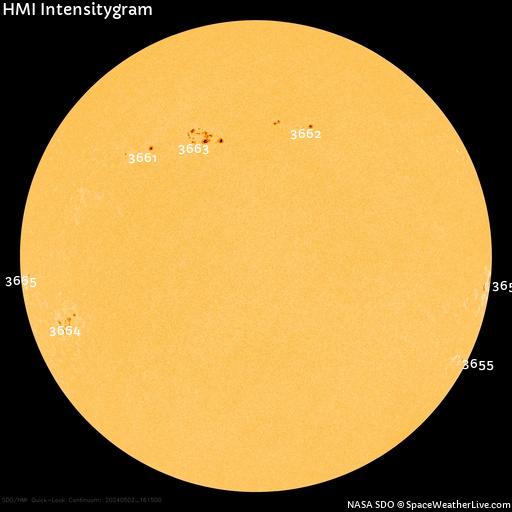Interesting days (and the days ahead)July 7:
1) Increased significantly Solar Wind for extended hours (several hours now) [with maximum proton density [reached] 13.8 (just a few minutes ago [now, while setting up this post, the time is ~1430 UT (± ...) ... (and just mentioning a local min now ~11.6 or 11.4 ...)]) (and a local maximum earlier today [13.4] - see below) ... – see ahead], "
oscilating" up and down (almost in a wave form) all this time now, between max and min values (but still the minima being significantly high too ... etc.), and with several LOCAL maxima and minima [in between, etc.] ... ... (see ahead):a)
"
| Solar wind
speed: 322.2 km/sec
density: 13.4 protons/cm3
more data: ACE, DSCOVR
Updated: Today at 1210 UT
X-ray Solar Flares
6-hr max: B5 1134 UT Jul07
24-hr: C1 1915 UT Jul06
explanation | more data
Updated: Today at: 1215 UT
Daily Sun: 07 Jul 21
Expand: labels | no labels
Sunspot AR2835 on the sun's western limb where it is magnetically connected to Earth through the Parker spiral. Credit: SDO/HMI |
"b)"
Solar wind
speed: 331.0 km/sec
density: 13.8 protons/cm3
more data:
ACE,
DSCOVR
Updated: Today at 1405 UT
X-ray Solar Flares
6-hr max: B5 1134 UT Jul07
24-hr: C1 1915 UT Jul06
explanation |
more data
Updated: Today at: 1410 UT
...
...
[& sunspot AR2835 on the sun's western limb where it is magnetically connected to Earth through the
Parker spiral. Credit: SDO/HMI]
"c) [and in between the two [highest] maxima(/values) ... (as an example of [the highest] local max ...): ]"
Solar wind
speed: 324.1 km/sec
density: 12.9 protons/cm3
more data:
ACE,
DSCOVR
Updated: Today at 1225
X-ray Solar Flares
6-hr max: B5 1134 UT Jul07
24-hr: C1 1915 UT Jul06
explanation |
more data
Updated: Today at: 1230 UT
"d) [and my first initial observation (starting point - perhaps local max too) earlier today ... :]"
Solar wind
speed: 325.1 km/sec
density: 12.8 protons/cm3
more data:
ACE,
DSCOVR
Updated: Today at 1105 UT
X-ray Solar Flares
6-hr max: B2 0716 UT Jul07
24-hr: C1 1915 UT Jul06
explanation |
more data
Updated: Today at: 1110 UT
[& Sunspot AR2835 on the sun's western limb where it is magnetically connected to Earth through the
Parker spiral. Credit: SDO/HMI]
"e) Other local maxima [in between values] (besides the 13.4 & 13.8 above ...) : 12, another 12.8, 11.9 (x2 [?]), 12.4, 11.8 ...
And local minima: 11.4, 11.6, ... ~11 (or less ... – couldn't tell accurately) and I think even ~10 ... (at some point in between, as the lowest min perhaps of the "
oscilation" ... [during this (observation) time [interval] ...]) [I do certainly recall a 10.8 and 10.9 ... ].f) + more recent high max too (13.8, again! ...) [or it may even have been higher (e.g. ~13.9 or even ~14 ... ...)] :
"
Solar wind
speed: 327.6 km/sec
density: 13.8 protons/cm3
more data:
ACE,
DSCOVR
Updated: Today at 1510 UT
X-ray Solar Flares
6-hr max: B5 1134 UT Jul07
24-hr: C1 1915 UT Jul06
explanation |
more data
Updated: Today at: 1515 UT
"g) + New ~significant flare (B7) ... :
"
Solar wind
speed: 323.7 km/sec
density: 12.4 protons/cm3
more data:
ACE,
DSCOVR
Updated: Today at 1620 UT
X-ray Solar Flares
6-hr max: B7 1551 UT Jul07
24-hr: C1 1915 UT Jul06
explanation |
more data
Updated: Today at: 1625 UT
"
2)
"
CO-ROTATING INTERACTION REGION: NOAA forecasters say there is a chance of geomagnetic unrest on
July 9th when a
co-rotating interaction region (CIR) is expected to hit Earth's magnetic field. CIRs are transition zones between slow- and fast-moving solar wind. Solar wind plasma piles up in these regions, producing CME-like density gradients that can spark auroras."3) Is today's intetesting behavior the result of a CME, or could it be a premature version/behavior or beginning/starting point (etc.) of the above phenomenon expected ~July 9th etc. ? ... [Any ideas, thoughts, questions ? ...]
Even tonight it may be a good oportunity for auroras etc., and in the days ahead (see above) etc. ...4) The major spot groups are gone now [from view] ... (just two in view for now, and relatively quiet ...).
The Sun overall, relatively quiet too (as far as flares etc.), despite the overall still intersting behavior today ... etc. :
Sunspot regions

Today's Sun
[Now (fairly recently, still today) – the other groups are gone – cf. above ... etc. .]
5) Another EVEN HIGHER maximum (local and 'localy absolute' [for today etc.] ... etc.) on proton density, while still originally writting this post (before accidental deletion and re-make ...) ... : ... "really high proton density [max ~15.4, at ~1700 UT] etc. ... ..."
Comments? Ideas?
[Post finally restored 2233UT ... √]


